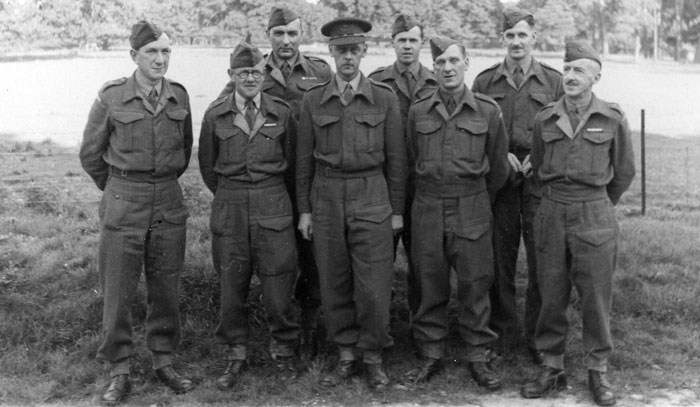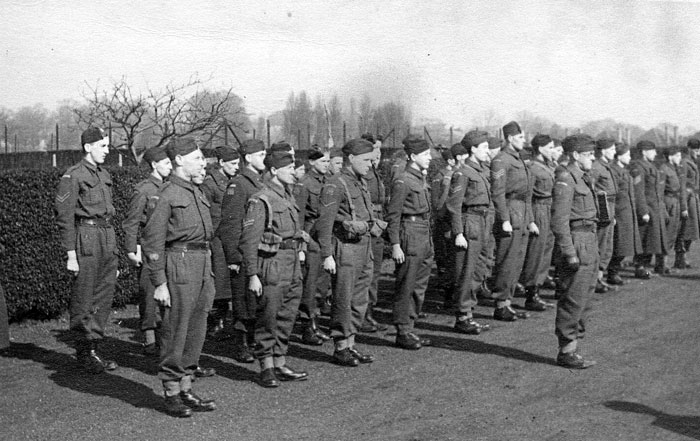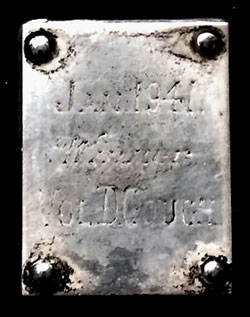This
is a page within the www.staffshomeguard.co.uk website.
To
see full contents, go to SITE
MAP.
HOME GUARD MEMORIES AND INFORMATION - WARWICKSHIRE, BIRMINGHA
23rd WARWICKSHIRE (BIRMINGHAM) BATTN.
ERDINGTON
and
Lt. LESLIE BEARD
|
 The
23rd Warwickshire (Birmingham) Battalion
bore the responsibility of
defending the Erdington
area of Birmingham. It was
commanded, first, by Lt.-Col.
S.A. Goodall M.C.
and later by
Lt.-Col. E.W. Walker The
23rd Warwickshire (Birmingham) Battalion
bore the responsibility of
defending the Erdington
area of Birmingham. It was
commanded, first, by Lt.-Col.
S.A. Goodall M.C.
and later by
Lt.-Col. E.W. Walker
Like these senior officers and
many other H.G. men in
positions of authority,
another officer in the
Battalion,
Lt. Leslie Beard
(right),
had served in the Great War.
Within Lt. Beard's
family there has survived a
great deal of information
about his experience in that
conflict and then, a little
over twenty years later, his
further contribution to the defence of
the country as a member of the
Birmingham Home Guard. This
section of the website
contains most of that
information and is arranged as
follows:
- Lt. Beard and
the 23rd Warwickshire Battalion
(this
page)
-
Artillery
training at Umberslade
Park, Hockley Heath
LESLIE BEARD:
EARLIEST DAYS,
GREAT WAR EXPERIENCE
AND CIVILIAN LIFE
 Leslie Beard
(1898-1972) was born
in
Bradford, Yorkshire
and started work there
in the textile
industry whilst still
at school in 1912. Leslie Beard
(1898-1972) was born
in
Bradford, Yorkshire
and started work there
in the textile
industry whilst still
at school in 1912.
In 1915 he joined
The Kings Own
Yorkshire Light
Infantry
as 37482 Pte.
L Beard. He went
overseas on Dec 31st
1917 and on 15th
January 1918 was
drafted to
"A" Coy,
9th (Service) Bn.
K.O.Y.L.I.
There
followed a fairly
normal pattern of
front line and reserve
duties until the
German Spring
Offensive which
commenced on 21st
Marxh 1918. Just two
days later, on the
23rd., Leslie was
captured at
Gurla
Wood, near
Peronne.
Like many of the
prisoners captured at
this time Leslie was
never shipped back to
Germany. He spent the
remainder of the war
under difficult
conditions working as
directed by the
Germans in different
locations on
ammunition dumps,
general labouring and
looking after horses
etc. The prisoners
were often short of
food as were the
Germans themselves.
Treatment was
generally poor.
The Armistice was
signed on Leslie’s
20th Birthday, 11th
November 1918 and the
prisoners started to
walk towards the
British lines. One of
Leslie’s friends,
Richard Lamb, was ill
and had to be left in
hospital in
St Denis,
Belgium. He died on
11th December. By 19th
November they had met
up with British troops
in the region of
Namur. They were
fairly speedily given
a bath, issued with
new clothing and
shipped back to the UK
arriving in Dover on
30th November. Leslie
arrived home in
Bradford on 3rd
December.
Leslie returned to
civilan life in the
textile industry in
Yorkshire, working for
Law Russell
(until its
liquidation in 1930),
Craven Mills,
Federated Mills
and
Gresham & Co.
Shortly
before the war he
moved to Birmingham to
work for
Frederick
Marsden Textiles and
continued to work for
them until his
retirement, initially
in their office in
Cannon Street
and
later as manager of
their
Densmar Mill
on
Foleshill Road
in
Coventry.
Throughout his time in
Birmingham Leslie
lived in with his wife
Minnie and their
daughter Betty in
Woodacre Road,
Erdington.
But as for so many
other families in
those times, life was
far from normal for
the Beards in the
years 1940 to 1944
when the impact of
World War 2 on
civilian life in
Birmingham was at its
height. In order to
avoid the Blitz, Betty
was sent off to live
with family at a safer
location in the North.
And in the summer of
1940 Leslie
volunteered to serve
in the local Home
Guard, thus willingly
committing himself to
thousands of hours of
unpaid work,
disruption and
discomfort which would
last for 4˝ years
until stand-down in
December 1944. |
Whilst no evidence of the
exact date of Leslie's volunteering
for the Home Guard survives, it is
very likley to have been in the days
or weeks following
Anthony Eden's
broadcast appeal for volunteers on
Tuesday May 14th 1940. Very rapidly
units were formed in every part of
Birmingham and they evolved in the
second part of 1940 into the Battalion
structure which was to remain largely
unchanged for the rest of the Home
Guard's life.
In
the first desperate days, rudimentary
command structures quickly appeared:
previous military experience was
regarded as essential for appointments
of authority and that is how Great War
privates suddenly found themselves
with officer or N.C.O. status in the
new service.
(See
this description
of how this process occurred in the
formation of a platoon in nearby
Streetly/Litte Aston). This was
the case with Leslie Beard: previous
experience and evident personal
qualities led to such an appointment
and we see his name appear in the
February 1941 Officers List:
2/Lt. L.
Beard, 23rd Warwickshire (Birmingham)
Battalion.
The surviving images
in the Beard family archive seem to
date mainly from later in the war. By
that time Leslie has his second pip
and he is now Lt. Beard, a rank he
would retain until the end of 1944. He
is a Platoon Commander, i/c No. 1
Platoon, "A" Coy.
These are the
images of various Battalion groups and
activities. They show Leslie's
comrades, some no doubt members of his
own Platoon and others clearly fellow
officers, possibly within his own
Company. (Identification of individuals
and locations would of course be
warmly welcomed).
(A second
series of images - all taken
at
Umberslade Park, Hockley Heath,
to the east of the city, and
showing Battalion members,
including Leslie, training on
artillery pieces - can be seen
on
an associated page).
In the first image, below, we
see all
or most of a Company, most
probably "A" Coy:
(The Company are grouped
outside a large sports
pavilion. This is a pavilion
overlooking a sports field
situated off
Woodacre Road in
Erdington. To the extreme
left, very indistinctly, are
the rear of houses in
Westmead Crescent. If
these men glance to their
half-right they will be
looking across a large expanse
of playing fields which
stretches right up to
Grange Road.. At the far
end of that expanse a few of
the men are to be seen, on
another occasion, practising
with a spigot mortar - see
image below. This area, and
the splendid building itself,
are thought to have been the
City Gas Department's
recreational grounds at that
time. The pavilion still
existed in 2017, in a much
modified and extended form,
and was the home of
Hollyfields Sports and
Conference Centre.)
Leslie Beard, front row, third
from right.
 "A" Coy. officers:
"A" Coy. officers:
Leslie Beard second from left.
Unknown location but possibly
similar to the Company image
above.
 Another officer group in a
summer garden setting:
Another officer group in a
summer garden setting:
Leslie Beard, front row,
second from right.

A
further group of officers in a
similar location
Leslie Beard, back
row, extreme left.

Leslie Beard and his Platoon,
No. 1, "A" Coy., on parade on
a sunny, winter's day:
Leslie at attention, standing
at the front of his men.


Summer camp at an unknown
location but probably
Umberslade Park:

Training on the Blacker
Bombard Spigot Mortar, on the
playing field in
Grange Road, Erdington:

Here is
the playing field in 1937, and
again in the 21st century,
with the mortar position
marked:
 |
 |
|
It seems as though
nothing has changed
over 80 years. But a
1945 view shows that
it did, for a while.
Temporary
pre-fabricated houses
("pre-fabs", rapidly
developed and
manufactured to ease
the acute post-war
housing shortage) came
in the intervening
period and then went
..... |
 |
Finally, perhaps one of
the more evocative images
in this series. A group of
officers and men,
including Leslie
(third right). Where are they? Where are they
off to, or coming back from?
Umberslade Park, perhaps, and
its weaponry training
courses? But if so, where is
their kit? It's a cigarette
(and pipe) moment as they
await their train. And what
has caught the eye of two or
three of these men? Something up
above. Is it just mild
curiosity or is there a look
of caution in their
expressions?
 But
perhaps we DO know where
these men are!
But
perhaps we DO know where
these men are!
The
station is almost
certainly
Wood
End,
on the Birmingham to
Stratford-upon-Avon line
of the
Great Western Railway.
This station is the
nearest to
Umberslade Park
and our group is waiting
for a train to take them
back to Snow Hill, whence
they will travel on to
their homes in and around
Erdington.
They have completed their day
or weekend of training. It's
possibly late on a Sunday
afternoon.
Over the
next twenty-five years the
1908 station buildings, behind
us as we look at the H.G.
group, deteriorate
significantly according to a
sad, mid-1960s
view, below.

And today
(18th March 2017),
after a further half-century,
the newly re-surfaced platform
still invites us to journey
onwards,
through the same cutting now
rich in foliage, to the centre
of Birmingham:

At some stage, as the
1940s group image above
indicates, members of the
Battalion were present at
Umberslade Park
to undergo training on
artillery pieces. Here is just
one of the photographs from
those days.
An associated
page
of the website is devoted
to this period of training and
contains many more images.
 |
In common with all
other Home Guard
units, Leslie Beard's
platoon encouraged
competition amongst
its members in order
to enhance the skills
being acquired.
An example survives
within Leslie's
effects - a cup for
shooting, won in
January 1941 by
Vol.
D. Gough. Was this
trophy perhaps
provided by Leslie? It
seems as though the
competition was
discontinued or, more
likely, similar cups
were competed for and
won by others in the
following years.
 |

 |
In the last few months
of 1944, when all risk of
invasion or major incursion
was deemed to have
disappeared, the Home Guard
started to wind down. On
Sunday 3rd December 1944,
every Battalion had a final
stand-down parade, in parallel
with the national event which
took place in Central London
and was attended by
representatives from all
Battalions throughout the
country. Erdington would also
have had its final parade:
images of it must have been
published but have so far not
come to light.
Like
many other Battalions, the
23rd Warwickshire organised at
least one Farewell Dinner,
held at the Yenton Masonic
Hall on Friday, 5th January
1945.
This was attended by Leslie and
other officers. His programme survives,
bearing the signatures of a
number of his comrades.
Amongst those who signed and
others who were mentioned are:
G. Blennerhassett - C.B.
Bridge
R. Gavison/R.G.
Avison(?) - Col. S.A.
Godsall, M.C. - Lt.-Col. V.W.
Grosvenor
Alec Hawkins/Hadkins/Madkins(?)
W.E. Lees
J. McCulloch - Maj.
A.J. Marsterson
G.C.(?)
Paul - C.G. Parr -
Lt. R.F. Port
... Raby
- Maj.
O.F. Rosbrook - E. Rothwell(?)
Miss E. Slugg - Maj. A.K.
Spencer
Maj. N. Valentine,
M.M.
Lt.-Col. E.W. Walker.

 |
|
In memory of
Lt. Leslie Beard
and all his comrades in
23rd Warwickshire (Birmingham) Battalion,
Home Guard
|
 |
Grateful acknowledgement
is
made to John Wright, and other
family members, for
the information about
his grandfather and
their generous
permission for its
publication; to Dave
Wasdell for the 2017
Wood End image; to
the unknown source of
the 1960s Wood End
image; to members of
the excellent
Birmingham History
Forum, especially
"oldMohawk" and "Pedrocut", for
information on
Erdington locations;
and to
BritainFromAbove
and Google Earth.
All images © John
Wright 2017
except
2017 Wood End image ©
Dave Wasdell 2017
and various aerial
images
x148A -
May 2017 revised June 2017
|
| |